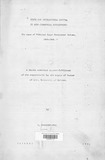| dc.description.abstract | Using Muhoroni Sugar Settlement Scheme as a single case study, we have attempted in this thesis to inquire into the socio-economic and political consequences of the interaction between state and international capital and the peasantry, under a scheme known as agro-industrial development.
Agro-industrial projects, refers to rural agricultural projects under which peasants are organized to produce cash crops, e.g. tea, coffee and sugar cane, to be processed by a multinational industry established within their midst for the purpose. Such rural projects always involve an alliance of state and international capital, an alliance whereby the state provides the political, ideological and administrative infrastructure while the financial support comes from the international finance capital sources, e.g. the World Bank.
It is argued that the aim of such projects is to create a stabilized ‘middle peasantry’ capable of reproducing it-self adequately from the ~and and at the same time specialize in commodity production for the interest of capital. The establishment of such, stabilized middle peasantry has' indeed been successful in some areas, and with regard to specific crops.
But in some common areas, such projects have led to the complete stagnation of the 'middle peasantry', with the majority of the peasantry being transformed into a class of wage laborers.
We argue in this thesis that any conditions on the peasant land ownership relations is a determinant factor on whether or not a 'middle peasantry' will be created. This is because the intrusion of international capital on the peasant household production has been known to transform peasant land ownership relations. In Muhoroni Settlement Scheme in particular, this was the case.
A work of this nature must of course be treated within an appropriate theoretical framework. Consequently, in Chapter I, we have tried to present some of the recent theories on peasant commodity production. This Chapter also serves as our introduction to the rest of the work. In Chapter II, we provide the historical background of the Scheme, showing the emergence of an alliance between state and international capital, the conditions which were created for the re-settlement process on the Scheme and how these conditions influenced the pattern of the settlement. Chapter III deals with labor process, i.e. the way in which production is organized and the consequences of this on new settlers.
Chapter IV deals with the way in which capital interacts with labor and the patterns of surplus-value appropriate that characterize these interactions. This Chapter also analyses the political processes which have accompanied this form of commodity production.
In Chapter V, we arrive at the conclusion that in Muhoroni Sugar Settlement Scheme, the Settlement Charges and Land Development loans which were imposed as the conditions for the peasants acquisition of plots have been the inhibiting factors to the successful establishment of a stabilized 'middle peasantry'. We therefore recommend that these conditions on the peasant land ownership relations be abolished. | en |

